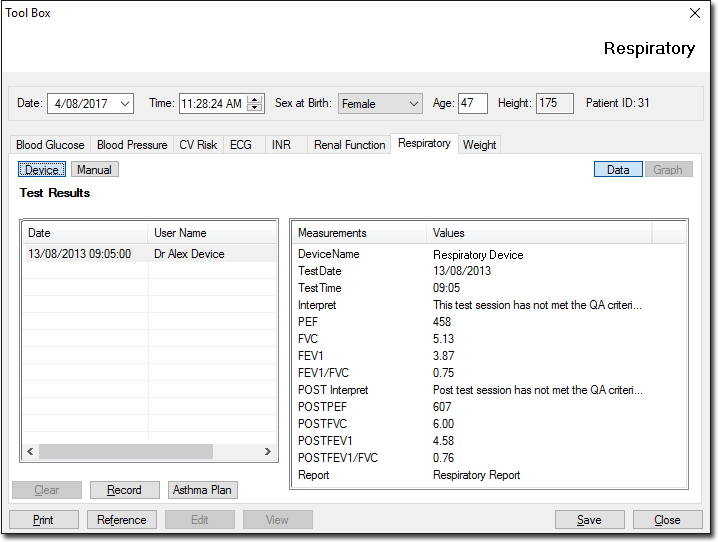
Ctrl + Alt + R
Tools > Tool Box > Respiratory Function (via the Clinical Window)
From within the Clinical Window, select Tools > Tool Box > Respiratory Function. The Respiratory tool appears.
Either:
Click
 to
use
a device to record values, or
to
use
a device to record values, or
Click
 to
enter values manually.
to
enter values manually.
The following image shows the Respiratory tool in 'device' mode.

Conduct the respiratory test with your patient and enter appropriate values in each of the PEFR, FEV1 and FVC fields for both the Pre and Post tests. The FER value will be calculated automatically.
Click
 to
remove any previously entered values if necessary (only available
when adding results manually).
to
remove any previously entered values if necessary (only available
when adding results manually).
Click
 to
save these details into the patient's clinical record (only available
when adding results manually).
to
save these details into the patient's clinical record (only available
when adding results manually).
To delete an entry, select it, and press Delete on your keyboard.
|
Device-mode, which allows you to take readings via a spirometer. |
|
Manual-mode, which allows you to enter readings manually. |
|
Display the patient's record as a list of data. |
|
Display the patient's record as a graph. |
|
Clears any data you enter into the Current Measurements section of the window. |
|
Initiates taking a recording from a respiratory device. This is only available when the Device button is enabled. |
|
Click to record an Asthma Action Plan. |
Prints the patient's respiratory data. If you have filtered the data, this will be reflected in the printout. |
|
|
Respiratory Predicted Values reference information. |
|
Not applicable to respiratory. |
|
Allows you to view a selected report saved to this tab.
Note that this button is only available if; You are using 'device' mode (as opposed to 'manual' mode). You have saved a respiratory report that was created using the associated device.
|
|
Save data to the patient's record. |
The following terms are used in MedicalDirector Clinical Respiratory Function Calculator module |
|
PEFR |
Peak Expiratory Flow Rate - is the maximum expiratory flow rate achieved and this occurs very early in the forced expiratory process. |
FEV1 |
Forced Expiratory Volume (in 1 sec) Recording - the volume expired in the first second of maximal expiration after a maximal inspiration. |
VC |
Vital Capacity - The maximum volume of air exhaled or inspired during either a formed (FVC) or a slow (VC) process. |
FEV1/FVC |
Is the FEV1 expressed as a percentage of the FVC (whichever volume is larger) and gives a clinically useful index of airflow limitation. |
FEF25-75% |
Is the average expired flow over the middle half of the FVC process and is regarded as a more sensitive measure of small airways narrowing than FEV1. Unfortunately FEF25-75% has a wide range of normality, is less reproducible than FEV1, and is difficult to interpret if the VC (or FVC) is reduced or increased. |
FVC |
Forced Vital Capacity - The maximum volume of air exhaled or inspired during either a formed FVC process. |







